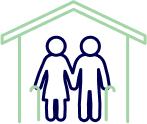SYMPTOMS TO SEVERE RESPIRATORY DISTRESS.4-7
SYMPTOMS MAY INCLUDE:
- Nasal Congestion2,3
-
- Rhinorrhea3
-
- Cough2,3
-
- Wheezing1

CLINICAL PRESENTATION
MAY INCLUDE4,7,8
- Bronchiolitis4
- Pneumonia7
- Croup7
- Apnea8
- Upper respiratory tract infection7

RSV MAY PROGRESS TO SEVERE COMPLICATIONS THAT RESULT IN9,10*
- Respiratory failure10
- Prolonged hospitalization10
- High mortality10

CLINICAL PRESENTATION
MAY INCLUDE2,3,5,11
- Upper respiratory tract infection2,3
- Exacerbation of asthma, chronic obstructive pulmonary disease, and chronic heart failure5
- Pneumonia11
RSV IS A VIRAL RESPIRATORY THREAT THAT CAN BE EASILY MISTAKEN FOR INFLUENZA1
In a study from Washington State, the incidence of RSV in infants seen at outpatient clinics was 7x higher than that of influenza17

PREMATURE INFANTS AND
THOSE 6 MONTHS AND YOUNGER19

CHILDREN YOUNGER THAN
2 YEARS WITH CHRONIC
MEDICAL CONDITIONS19

OLDER ADULTS20

THOSE LIVING IN NURSING HOMES
OR LONG-TERM CARE FACILITIES20

THOSE WITH AN
IMMUNODEFICIENCY OR CHRONIC
HEART OR LUNG DISEASE19,20

THOSE WITH CERTAIN OTHER
UNDERLYING CONDITIONS19,20
TAKE THIS QUIZ TO FIND OUT
TAKE THIS QUIZ TO FIND OUT
SERIOUS OUTCOMES1-3,5
HEAR REAL PEOPLE SHARE HOW RSV HAS AFFECTED THEIR LIVES

OLDER adults


